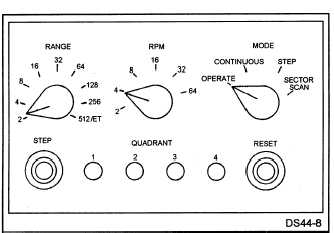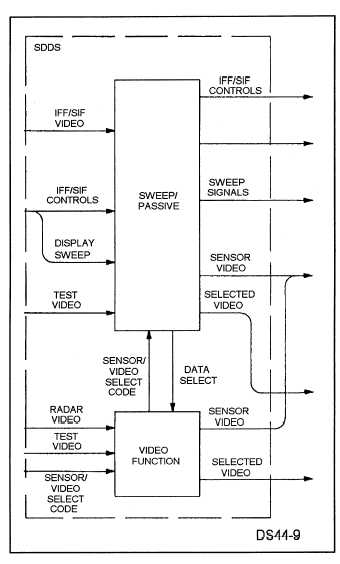azimuth data are decoded for DC/DU position and the
2 MSBs are decoded for quadrant data to form the
sign of DC/ sign of DU. In self-test mode, the azimuth
data is generated by the control, timing, and test
function.
The polar-to-Cartesian converter also
produces range marks.
DIGITAL TRANSMITTER FUNCTION.— The
digital transmitter function transmits the sweep data
to the sensor data distribution switchboard. This data
is the DC/DU pulse trains, sign of DC and sign of DU,
range marks, end-of-sweep, and analog azimuth
signals. The digital transmitter function also sends
parallel azimuth data to the system’s computer via a
multiplexer.
SRAC CONTROL PANEL.— The SRAC control
panel allows the operator to monitor and control the
operation of the SRAC. Figure 4-8 shows the SRAC
control panel.
For normal operation, the MODE
switch must be in the OPERATE position. If the
MODE switch is in the CONTINUOUS position,
timing and azimuth data are generated by the control,
timing, and test function.
Sweep rotation is
Figure 4-8.—The SRAC control panel.
normally in the 512/ET position, but maybe placed in
the desired range to generate an internal end-of-sweep
signal. The control panel for the DRAC is identical to
the control panel for the SRAC.
SENSOR DATA DISTRIBUTION
SWITCHBOARD (SDDS)
The sensor data distribution switchboard (SDDS)
distributes azimuth data from the RAC and video
from the radar to the display consoles. The SDDS
occupies two drawers in the CEG. One drawer is the
sweep/passive or sweep/IFF SDDS. The other drawer
is the video SDDS. The SDDS can route inputs from
up to 12 sensors to 20 display consoles. The SDDS
can be expanded to provide outputs to 40 display
consoles by installing two of each drawer in the CEG.
A block diagram of the SDDS is shown in figure 4-9.
continuous and clockwise. Speed of the simulated
sweep is controlled by the RPM switch. The STEP
mode enables use of the STEP pushbutton. The
azimuth of the simulated sweep is incremented one
time for every depression of the STEP pushbutton. In
the SECTOR SCAN mode, a 45-degree simulated
sweep is generated that alternately scans clockwise
and counter-clockwise.
The RANGE switch is
Figure 4-9.–The sensor data distribution switchboard.
4-7



